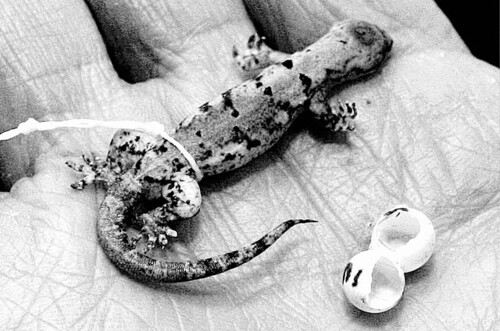tags: Lepidodactylus buleli, new species discovered, Vanuatu gecko, reptiles, Ivan Ineich, Natural History Museum Paris France
French scientist, Ivan Ineich, displays a never-before-seen species of gecko at France's Natural History Museum in Paris. This gecko, formally described with the Latin name, Lepidodactylus buleli, was born in Paris from an egg that was removed from the rainforest canopy on the west coast of Espiritu Santo, one of the larger islands of the Vanuatu Archipelago, east of Australia in the South Pacific Ocean.
IMAGE: Francois Mori (AP Photo) [larger view].
According to scientists at France's National Museum of Natural History, a new species of gecko has been discovered -- after it hatched from an egg removed from a nest on a South Pacific island and carried 12,000 miles to Paris in a box lined with Kleenex. The island, Espiritu Santo, is one of the larger South Pacific islands of the Vanuatu Archipelago, east of Australia.
The new reptile species, which was formally assigned the Latin name, Lepidodactylus buleli, is only three inches long as an adult, and lives near the tops of the rainforest on the west coast of Espiritu Santo, eating insects and possibly drinking nectar from flowers.
Geckos are small to medium-sized reptiles in the family Gekkonidae. These fascinating animals are unique among lizards because they are vocal: their social interactions frequently involve chirping sounds. Many geckos also have specialized toe pads that rely on weak intermolecluar attractive forces, known as van der Waals forces, to enable them to climb smooth and vertical surfaces, and even to stroll upside down across ceilings. It is estimated that there are roughly 2,000 species of geckos throughout the worldwide -- and many are still to be discovered.
The egg was collected, along with eight others, from a nest that had been found in the treetops during a collecting trip to Espiritu Santo in 2006. Ivan Ineich, the museum's herpetologist, noticed a bloody carcass that had accidentally hacked in half by one of collectors.
"I said to myself 'this guy looks bizarre,' but I couldn't tell right away it was a new species because it had been so massacred," Ineich said.
Climbers later collected a plant where nine minuscule gecko eggs had been hidden. Ineich wrapped the eggs in wet Kleenex, packed them into a pillbox and carried them home, where he gave them to a friend who raises lizards as a hobby. Unfortunately, eight of the geckos died after temperatures in the terrarium plummeted during a power outage, but the ninth -- the holoype that you see in the images -- lived.
This is the first time a new species of lizard has been identified from an individual raised from an egg rather than from adults collected from the wild, according to France's National Museum of Natural History.
This new species of gecko is not thought to be endangered.
New species of gecko, Lepidodactylus buleli, discovered on the island of Espiritu Santo, in the Vanuatu Archipelago. This animal was collected as an egg and hatched in France.
IMAGE: orphaned [larger view].
Sources:
Ivan Ineich (2008). A new arboreal Lepidodactylus (Reptilia: Gekkonidae) from Espiritu Santo Island, Vanuatu: from egg to holotype. Zootaxa, 1918, 26-38. ISSN: 1175-5334 [abstract PDF].
LJIWorld (quote).



That reminds me of a comment by Pratchett (?) that the most intelligent species on Earth is the one we haven't found yet.
Headline should read:
"Scientist hacks up mother of a lizard family, eggnaps baby! Lizard very cute and assumed endangered. Scientist less cute and assumed moronic."
:-P
Ouuuuuuu - I luv new discoveries!! Thanks for posting!!!!!!!!!!!! ~ Diane in Ohio :o)
Isn't there laws against the remonal of species from certain areas?
It's the lizard who lived! Why didn't they name it Lepidodactylus harrypotteri? You know that the Dark Lizard Varanimort is monitoring this situation....
Belatedly I find this very cool post via a blog carnival. Geckos rock.
"Dark Lizard Varanimort" = awesome.
Poor Varanids though; I even heard someone compare Anne Coulter to a monitor lizard. Grossly unfair if you ask me.
I grew up there. Never saw a gecko like that though!
It's so cute!!! I want one :)